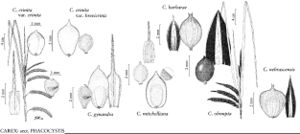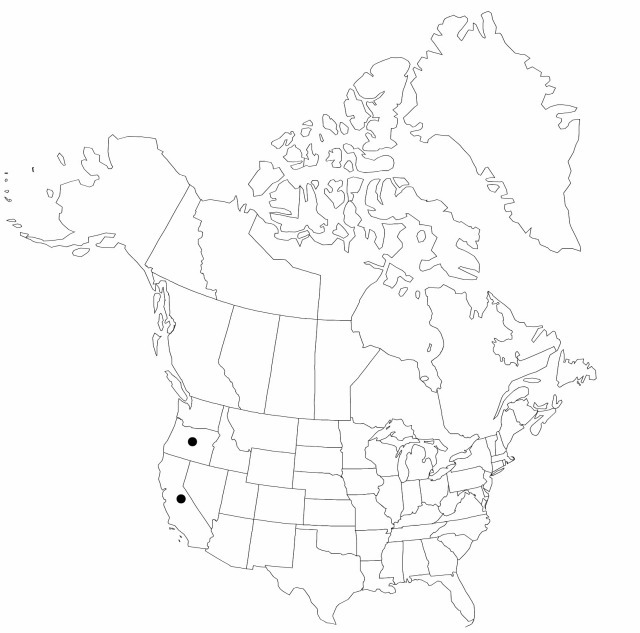Difference between revisions of "Carex barbarae"
in W. H. Emory, Rep. U.S. Mex. Bound. 2(1): 231. 1859.
FNA>Volume Importer |
FNA>Volume Importer |
||
| Line 11: | Line 11: | ||
|name=Carex laciniata | |name=Carex laciniata | ||
|authority=Boott | |authority=Boott | ||
| − | }}{{Treatment/ID/Synonym | + | }} {{Treatment/ID/Synonym |
|name=Carex lacunarum | |name=Carex lacunarum | ||
|authority=T. Holm | |authority=T. Holm | ||
| Line 29: | Line 29: | ||
|elevation=0–1000 m | |elevation=0–1000 m | ||
|distribution=Calif.;Oreg. | |distribution=Calif.;Oreg. | ||
| − | |discussion=<p>A widely distributed, variable species, Carex barbarae is best identified using material with well-developed perigynia. Carex barbarae shares distinctive characteristics with C. obnupta, particularly the sessile, pendent, basally acuminate spikes, the leathery leaves, and the inflated, leathery, glabrous perigynia. Carex barbarae differs in having the scales awned and scabrous at the apex, and the perigynia faintly veined and dull brown, with a scabrous, firm, bidentate beak, all of which are similar to those of C. nebrascensis. Mature fruiting plants of C. barbarae have rarely been collected, suggesting that the species is largely sterile. The relationships among these three species merit investigation because the morphology and sterility of C. barbarae suggest that it may have a hybrid origin.</p> | + | |discussion=<p>A widely distributed, variable species, <i>Carex barbarae</i> is best identified using material with well-developed perigynia. <i>Carex barbarae</i> shares distinctive characteristics with <i>C. obnupta</i>, particularly the sessile, pendent, basally acuminate spikes, the leathery leaves, and the inflated, leathery, glabrous perigynia. <i>Carex barbarae</i> differs in having the scales awned and scabrous at the apex, and the perigynia faintly veined and dull brown, with a scabrous, firm, bidentate beak, all of which are similar to those of <i>C. nebrascensis</i>. Mature fruiting plants of <i>C. barbarae</i> have rarely been collected, suggesting that the species is largely sterile. The relationships among these three species merit investigation because the morphology and sterility of <i>C. barbarae</i> suggest that it may have a hybrid origin.</p> |
|tables= | |tables= | ||
|references= | |references= | ||
| Line 53: | Line 53: | ||
|publication year=1859 | |publication year=1859 | ||
|special status= | |special status= | ||
| − | |source xml=https://jpend@bitbucket.org/aafc-mbb/fna-data-curation.git/src/ | + | |source xml=https://jpend@bitbucket.org/aafc-mbb/fna-data-curation.git/src/8f726806613d60c220dc4493de13607dd3150896/coarse_grained_fna_xml/V23/V23_686.xml |
|genus=Carex | |genus=Carex | ||
|section=Carex sect. Phacocystis | |section=Carex sect. Phacocystis | ||
Revision as of 16:10, 18 September 2019
Plants not cespitose. Culms obtusely angled, 30–110 cm, glabrous. Leaves: basal sheaths brown; sheaths of proximal leaves scabrous, fronts with red-brown spots or uniformly red-brown, prominently ladder-fibrillose, apex U-shaped, red-brown; blades hypostomic, 4–9 mm wide, coriaceous, papillose abaxially. Inflorescences: proximal bract longer than inflorescence, 3–8 mm wide. Spikes erect, the proximal pendent, sessile or pedunculate; staminate 2–3; pistillate 4–6; the proximal pistillate spike 3–10 cm × 5–6 mm, base attenuate. Pistillate scales red-brown, longer than perigynia, apex acute, scabrous, awned, awn to 2 mm. Perigynia divergent, dark pale brown with red-brown spots on apical 1/2, faintly 3–5-veined on each face, somewhat inflated, loosely enclosing achenes, ellipsoid or obovoid, 3–4 × 2.2–2.5 mm, leathery, dull, apex rounded or obtuse, glabrous; beak red-brown, 0.5 mm, bidentate, orifice scabrous. Achenes not constricted, dull.
Phenology: Fruiting Jul–Aug.
Habitat: Wet meadows, fields, stream banks
Elevation: 0–1000 m
Discussion
A widely distributed, variable species, Carex barbarae is best identified using material with well-developed perigynia. Carex barbarae shares distinctive characteristics with C. obnupta, particularly the sessile, pendent, basally acuminate spikes, the leathery leaves, and the inflated, leathery, glabrous perigynia. Carex barbarae differs in having the scales awned and scabrous at the apex, and the perigynia faintly veined and dull brown, with a scabrous, firm, bidentate beak, all of which are similar to those of C. nebrascensis. Mature fruiting plants of C. barbarae have rarely been collected, suggesting that the species is largely sterile. The relationships among these three species merit investigation because the morphology and sterility of C. barbarae suggest that it may have a hybrid origin.
Selected References
None.

